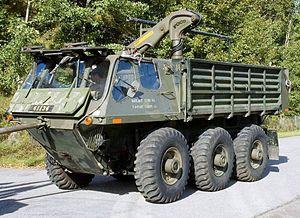LCV-61
| LCV-61 | |
|---|---|
 An LCV-61 G2 | |
| Type | 5-tonne 6×6 tactical truck |
| Place of origin | Khyragus |
| Production history | |
| Manufacturer | Sevir Heavy Industries |
| Produced | 1961–present |
| Specifications (LCV-61 G3) | |
| Length | 6.5 m |
| Width | 2.6 m |
| Height | 2.3 m |
| Crew | 1 (driver), 2–14 passengers |
| Armor | Small arms protection up to 7.62x51mm |
Main armament | Can mount various light machineguns, typically LMTG-78 or MTG-54 |
| Engine | SHI GMDE-B608 Flat six cylinder diesel 260 hp (194 kW) |
| Payload capacity | 5 tonnes (5.5 tons) |
| Transmission | 5-speed automatic |
| Ground clearance | 46 cm (18.1 in) |
Operational range | 650 km (404 mi) |
| Speed | 100 km/h (62 mph) (land) 15 km/h (9 mph) (water) |
The LCV-61 is a family of 6×6 highly mobile amphibious military truck developed for the Armed Forces of Khyragus. It was designed to transport a load of 5,000 kg (11,023 lbs) across all terrains and in all weather. Since its introduction in 1961, it has been upgraded in 1989 (G2 version) and again in 2006 (G3 version).
History
The LCV-61 was developed in the late 1950s as a replacement vehicle for the Khyragusian military's fleet of 3½ tonne LCV-38 tactical trucks. The first prototype was developed in 1958 and official entered service in 1961. In addition to various mechanical and performance upgrades, the LCV-61 was capable of amphibious operation and included a weapons mount on the roof, allowing it to operate as a gun truck.
In 1989, an upgrade program was started for the LCV-61, which added a turbocharged engine, an upgraded drive system, small arms protection, and an upgraded suspension system. Upgraded vehicles received the designation LCV-61 G2, whereas the designation LCV-61 G1 was applied to previous vehicles.
In 2006, the LCV-61 was extensively redesigned and upgraded to the LCV-61 G3. The LCV-61 G3 upgrades added a modernized engine with greater fuel efficiency, a lighter weight protection system with mine blast resistant seats, and the ability to mount a remote controlled weapon station in place of the crew served roof machine gun mount. Other improvements included a redesigned water propulsion system, air conditioning, an anti-lock braking system, and a new driver instrument panel.
Design
The LCV-61 family shares a common chassis and cab on a 6×6 platform. It is constructed from an internally-reinforced, waterproof, aluminum hull which serves as the vehicle chassis. The chassis is equipped with independent suspension for all wheels and portal axles for improved ground clearance. The front is equipped with a 20,000 lb (9,100 kg) winch for self-recovery. The cab is reinforced with internal rollover bars and seats 3. The cab can be entered by the two roof top hatches or side windows that swing open.
The load deck is surrounded by drop down panels with waterproof seals, though these may be omitted depending on the load.
The engine is housed beneath the cab, accessible from inside the vehicle.
Engines
Initially, the LCV-61 was equipped with the GMDE-B602 13.8 liter naturally aspirated flat six cylinder diesel engine developing 220 horsepower (164 kW). The G2 models added a turbocharger to the GMDE-B602 engine increasing the output to 270 horsepower (201 kW). The LCV-61 G3 models use the newer GMDE-B608 8.2 liter turbocharged engine which produces 260 horsepower.
All engines equipped on the LCV-61 are multifuel, allowing them to operate on a variety of fuels.
In water, the LCV-61 is propelled by a water jet propulsion system. In G3 versions, the water jet is electrically driven to reduce maintenance.
Variants
Note that specifications apply to the versions (G1,G2, and G3) of each model listed below.
| K | Basic cargo variant, removable soft top for rear load deck |
| KR | Equipped with hydraulic crane |
| V | Hard top compartment mounted to rear load deck |
| VKW | CRBN protected hard top compartment mounted to rear load deck |
| A | Ambulance |
Operators
Military Operators
Civilian Operators
 Khyragus - Khyragus National Petroleum Corporation, used to support oil field exploration and maintenance
Khyragus - Khyragus National Petroleum Corporation, used to support oil field exploration and maintenance
